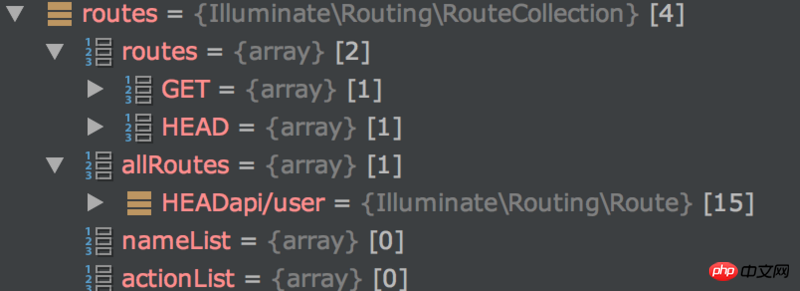Laravel框架下路由的使用(源码解析)
Posted it-world
tags:
篇首语:本文由小常识网(cha138.com)小编为大家整理,主要介绍了Laravel框架下路由的使用(源码解析)相关的知识,希望对你有一定的参考价值。
本篇文章给大家带来的内容是关于Laravel框架下路由的使用(源码解析),有一定的参考价值,有需要的朋友可以参考一下,希望对你有所帮助。
前言
我的解析文章并非深层次多领域的解析攻略。但是参考着开发文档看此类文章会让你在日常开发中更上一层楼。
废话不多说,我们开始本章的讲解。
入口
Laravel启动后,会先加载服务提供者、中间件等组件,在查找路由之前因为我们使用的是门面,所以先要查到Route的实体类。
注册
第一步当然还是通过服务提供者,因为这是laravel启动的关键,在 RouteServiceProvider 内加载路由文件。
|
1
2
3
4
5
6
7
|
protected function mapApiRoutes()
{
Route::prefix(‘api‘)
->middleware(‘api‘)
->namespace($this->namespace)
->group(base_path(‘routes/api.php‘));
}
|
首先require是不可缺少的。因路由文件中没有命名空间。 IlluminateRoutingRouter 下方法
|
1
2
3
4
5
6
7
8
9
10
|
protected function loadRoutes($routes)
{
if ($routes instanceof Closure) {
$routes($this);
} else {
$router = $this;
require $routes;
}
}
|
随后通过路由找到指定方法,依旧是 IlluminateRoutingRouter 内有你所使用的所有路由相关方法,例如get、post、put、patch等等,他们都调用了统一的方法 addRoute
|
1
2
3
4
|
public function addRoute($methods, $uri, $action)
{
return $this->routes->add($this->createRoute($methods, $uri, $action));
}
|
之后通过 IlluminateRoutingRouteCollection addToCollections 方法添加到集合中
|
1
2
3
4
5
6
7
8
9
10
|
protected function addToCollections($route)
{
$domainAndUri = $route->getDomain().$route->uri();
foreach ($route->methods() as $method) {
$this->routes[$method][$domainAndUri] = $route;
}
$this->allRoutes[$method.$domainAndUri] = $route;
}
|
添加后的结果如下图所示

调用
通过 IlluminateRoutingRouter 方法开始运行路由实例化的逻辑
|
1
2
3
4
5
6
7
8
9
10
11
12
13
14
15
16
17
18
19
20
21
22
23
24
25
26
27
28
29
|
protected function runRoute(Request $request, Route $route)
{
$request->setRouteResolver(function () use ($route) {
return $route;
});
$this->events->dispatch(new EventsRouteMatched($route, $request));
return $this->prepareResponse($request,
$this->runRouteWithinStack($route, $request)
);
}
....
protected function runRouteWithinStack(Route $route, Request $request)
{
$shouldSkipMiddleware = $this->container->bound(‘middleware.disable‘) &&
$this->container->make(‘middleware.disable‘) === true;
$middleware = $shouldSkipMiddleware ? [] : $this->gatherRouteMiddleware($route);
return (new Pipeline($this->container))
->send($request)
->through($middleware)
->then(function ($request) use ($route) {
return $this->prepareResponse(
$request, $route->run()
);
});
}
|
在 IlluminateRoutingRoute 下 run 方用于执行控制器的方法
|
1
2
3
4
5
6
7
8
9
10
11
12
13
14
|
public function run()
{
$this->container = $this->container ?: new Container;
try {
if ($this->isControllerAction()) {
return $this->runController();
}
return $this->runCallable();
} catch (HttpResponseException $e) {
return $e->getResponse();
}
}
|
从上述方法内可以看出 runController 是运行路由的关键,方法内运行了一个调度程序,将控制器 $this->getController() 和控制器方法 $this->getControllerMethod() 传入到 dispatch 调度方法内
|
1
2
3
4
5
6
7
|
protected function runController()
{
return $this->controllerDispatcher()->dispatch(
$this, $this->getController(), $this->getControllerMethod()
);
}
|
这里注意 getController() 才是真正的将控制器实例化的方法
|
1
2
3
4
5
6
7
8
9
10
|
public function getController()
{
if (! $this->controller) {
$class = $this->parseControllerCallback()[0];
$this->controller = $this->container->make(ltrim($class, ‘\‘));
}
return $this->controller;
}
|
实例化
依旧通过反射加载路由指定的控制器,这个时候build的参数$concrete = AppApiControllersXxxController
|
1
2
3
4
5
6
7
8
9
10
11
12
13
14
15
16
17
18
19
20
21
22
23
24
25
26
27
28
29
30
31
32
33
34
35
36
37
38
39
40
41
42
43
|
public function build($concrete)
{
if ($concrete instanceof Closure) {
return $concrete($this, $this->getLastParameterOverride());
}
$reflector = new ReflectionClass($concrete);
if (! $reflector->isInstantiable()) {
return $this->notInstantiable($concrete);
}
$this->buildStack[] = $concrete;
$constructor = $reflector->getConstructor();
if (is_null($constructor)) {
array_pop($this->buildStack);
return new $concrete;
}
$dependencies = $constructor->getParameters();
$instances = $this->resolveDependencies(
$dependencies
);
array_pop($this->buildStack);
return $reflector->newInstanceArgs($instances);
}
|
这时将返回控制器的实例,下面将通过url访问指定方法,一般控制器都会继承父类 IlluminateRoutingController ,laravel为其设置了别名 BaseController
|
1
2
3
4
5
6
7
8
9
10
11
12
13
14
|
public function dispatch(Route $route, $controller, $method)
{
$parameters = $this->resolveClassMethodDependencies(
$route->parametersWithoutNulls(), $controller, $method
);
if (method_exists($controller, ‘callAction‘)) {
return $controller->callAction($method, $parameters);
}
return $controller->{$method}(...array_values($parameters));
}
|
Laravel通过controller继承的callAction去调用子类的指定方法,也就是我们希望调用的自定义方法。
|
1
2
3
4
|
public function callAction($method, $parameters)
{
return call_user_func_array([$this, $method], $parameters);
}
|
以上是关于Laravel框架下路由的使用(源码解析)的主要内容,如果未能解决你的问题,请参考以下文章
Laravel框架关键技术解析
Laravel 5.3 用户验证源码探究 路由与注册
Android源码解析一篇搞定“路由网络层UI层通信层....百大框架”源码解析,阿里大牛神级之作
ThinkPHP框架系统源码解析——URL路由解析
Laravel源码分析——看一次Http请求到响应
Laravel源码解析之从入口开始
